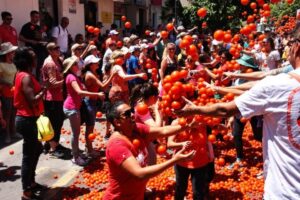
Culture

-
The History of Cuban Drums: A Legacy of Rhythm and Tradition
The history of Cuban drums dates back to pre-Columbian times, when indigenous peoples used wooden percussion instruments to create rhythmic vibrations. However, it was the arrival of African slaves that transformed Cuban drumming, introducing animal skin drumheads and shaping the distinct sounds that define Cuban percussion today. The Evolution of Afro-Cuban Drumming With the need […]
-
Guava: Timeless Fruit and Natural Treasure of Latin America
Guava a treasured fruit that embodies the cultural and natural richness of Latin America. This ancient plant, native to tropical America, has been valued for centuries both for its delicious fruit and its medicinal properties. An Ancestral Legacy in Every Bite Guava, a member of the myrtle family, stands as a vital part of Latin […]
-
Mate: Argentina’s Timeless Tradition of Connection and Identity
Mate is more than just a drink in Argentina—it is a symbol of friendship, community, and tradition, deeply embedded in the country’s cultural identity. Origins and Evolution Mate traces its origins to the Guaraní communities, who discovered its stimulating properties long before European colonizers arrived. Jesuits played a crucial role in spreading its cultivation and […]
-
Indigenous Peoples’ Film and Communication Festival Returns to Peru After 35 Years
More than 50 films from 12 countries will be screened free of charge at the International Film and Communication Festival of Indigenous Peoples, which will return to Peru after 35 years, according to the Cultural Center of Spain in Lima. RELATED: Bossa Nova: Brazil’s Cultural Treasure and Global Musical Influence The fifteenth edition of the […]
-
San Salvador: History, Monuments, and Tourist Attractions in the Salvadoran Capital
San Salvador, the capital of El Salvador, is the country’s political, economic, and cultural center. Founded in 1525 by Spanish conquistador Pedro de Alvarado, the city has been the setting for key moments in national history, from independence movements to the signing of the Peace Accords in 1992. RELATED: A Taste of the Caribbean: Jamaica’s […]
-
Eid al-Adha: A Global Celebration of Faith, Community, and Tradition
Eid al-Adha, also known as the Festival of Sacrifice, is one of the most significant celebrations in Islam, observed by over two billion Muslims worldwide. Eid al-Adha honors the Prophet Abraham’s willingness to sacrifice his son in obedience to God. According to Islamic tradition, God intervened and provided a ram instead, symbolizing faith, devotion, and […]
-
A Taste of the Caribbean: Jamaica’s Vibrant Fruit Culture
Jamaica, known for its rich cultural heritage, reggae music, and stunning landscapes, is also home to a diverse array of tropical fruits that define its culinary identity. From mangoes and June plums to soursop and guava, Jamaica’s fruit selection is as vibrant as its culture. While mangoes are widely available, many of these exotic fruits […]
-
Sutamarchán’s Great Tomatina: A Celebration of Tradition and Agriculture
The Great Tomatina of Sutamarchán once again turned the streets of this picturesque Colombian town into a sea of red, bringing together thousands of participants in a festival that honors the local tomato-based economy. Inspired by Spain’s La Tomatina, this Colombian version has become a major cultural event, attracting visitors from across the country and […]
-
Bossa Nova: Brazil’s Cultural Treasure and Global Musical Influence
The City of Rio de Janeiro has officially declared Bossa Nova as cultural heritage, recognizing its profound impact on Brazilian identity and global music. Emerging in the late 1950s, Bossa Nova blended samba rhythms with jazz harmonies, creating a sophisticated yet intimate sound. The genre was pioneered by João Gilberto, Tom Jobim, and Vinicius de […]
-
Pelourinho: The Living Heart of Salvador de Bahia’s Colonial Heritage
The historic center of Salvador de Bahia, known as Pelourinho, stands as a vibrant testament to the cultural fusion that defines Brazil. Founded in 1549 by Tomé de Sousa as the country’s first capital, Salvador became a melting pot of European, African, and Indigenous influences. RELATED: San Luis Potosí: Cultural and Historical Heart of Mexico […]
-
San Luis Potosí: Cultural and Historical Heart of Mexico
San Luis Potosí, capital of the state of the same name, stands as a vibrant cultural and economic center in Mexico’s central highlands. Founded on November 3, 1592, the city owes its origin to the discovery of gold and silver mines in the nearby Cerro de San Pedro, earning it the nickname “Potosí” in reference […]
-
Baracoa’s Chocolate Legacy: A Tradition of Passion and Resilience
In Baracoa, Cuba’s chocolate capital, the legacy of cacao cultivation and chocolate production remains deeply woven into the town’s identity. For José Alexander Eugellés, who has worked in Baracoa’s chocolate factory for 28 years, crafting chocolate is more than a profession—it’s a way of life, inherited from his father and shared with his sister. The […]
-
National Botanical Garden of Havana: A Natural Treasure for Science and Conservation
Just 25 kilometers south of Havana, the National Botanical Garden (JBN) stands as Cuba’s largest and most important botanical reserve, blending scientific research, conservation, and ecotourism in a stunning natural environment. Founded at the request of Fidel Castro and led by German botanist Dr. Johannes Bisse, the project took nearly two decades to develop, officially […]
-
Cartagena de Indias: Colombia’s Caribbean Jewel of History and Culture
Nestled along Colombia’s Caribbean coast, Cartagena de Indias stands as a city of rich history, vibrant culture, and sun-drenched landscapes, blending colonial charm with modern energy. Founded in 1533, Cartagena’s fortified walls tell the story of a strategic port, once plundered by pirates, now recognized as a UNESCO World Heritage site. Its cobbled streets, lively […]

















